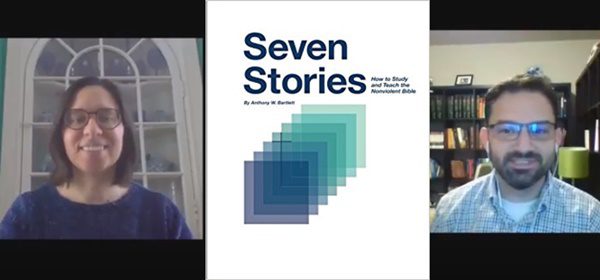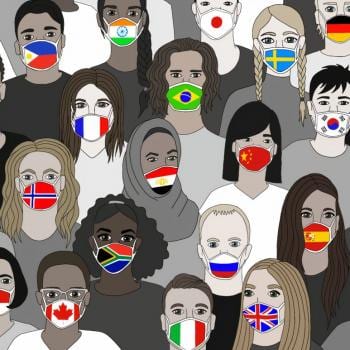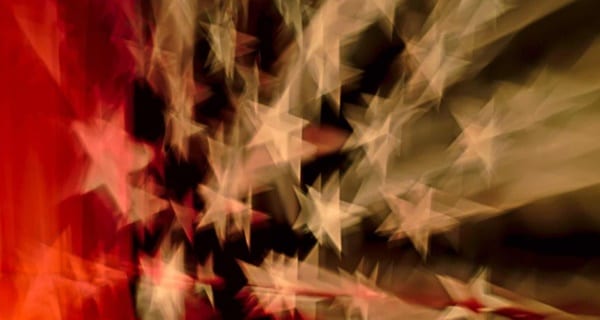In this episode of the RavenCast, Adam Ericksen and I discuss the second chapter Anthony Bartlett’s latest book Seven Stories: How to Study and Teach the Nonviolent Bible. You can watch the video of the conversation below, or listen to the podcast above. You can also subscribe to the RavenCast on iTunes, Stitcher Radio, or Podbean.
Genesis is a theological meditation that implicitly reverses all the violence of Israel’s history. Both violence and love are imitative and generative processes, but with very different results. Genesis tells us that God’s plan is for us to choose generative nonviolence and forgiveness over generative violence. – Anthony Bartlett, Seven Stories, Story 2: “Violence to Forgiveness.”
Last week, Adam and I talked about the “first” story: “From Oppression to Justice.” Tony starts his Bible Study with the story of the Exodus, showing how this story, the story of escape from slavery to freedom, is the beginning of the Hebrew cultural identity. It is important to recognize the Hebrews not as an ethnicity, but as people connected by an experience of displacement, marginalization, and oppression. God’s “chosen people” are not a race but people who have been forced to or beyond the edges of their own communities. God’s love is universal, but God intentionally includes and works through the excluded. Tony helps us understand that God’s peace is rooted in justice – in recognition of the dignity of all, in inclusion, in freedom. God’s peace is not a passive complacency with suffering and oppression. Before we move on to the second story, “From Violence to Forgiveness,” we must understand that the call to forgiveness is not a call to allow oppressors to continue in their oppression or abusers to continue in their abuse. The full love of God leaves no room for treating human beings – or indeed any part of creation – without respect and dignity.
With that established, Adam and I turn to story number 2: “From Violence to Forgiveness.” Here we get into Genesis, which Tony describes as a theological preview of the trajectory of the rest of scripture – a critique on violence and a lesson in forgiveness. Each of the seven stories are subdivided into three parts, with lessons 1 and 2 focusing on Genesis – first the “prehistories” and then the “patriarchs” – and then turning in lesson 3 to Jesus with the story of the Prodigal Son.
The prehistories focus on Genesis chapters 2 -11 with the stories of the exile from the Garden, Cain’s murder of Abel, the “sons of God and daughters of men,” the flood, and the tower of Babel. In each of these stories, God is presented as a rival figure to humanity, because freedom, desire, and rivalry are intimately connected.
To understand the connection between freedom, desire, and rivalry, it is important to understand ourselves as creatures of relationship and imitation rather than instinct. We are made in relationship with God and with one another, and our desires come from imitating the desires of others. We learn what love is and what to love through watching and relating to others. Without relationship and learning from models, we would be bound by instinct, innately pulled to the things we need, guided not by thought or emotion but simply survival. But as relational creatures we learn from the desires of others. Our relationships show us what to desire, but they also put us in rivalry with one another when we don’t want to share our desires, or when we want to take the place of our role models because we want their talent or status for ourselves.
The story of the Garden of Eden shows how as human desire was kindled, a perceived rivalry between humans and God was also kindled. The serpent tells Eve that God is prohibiting her from eating of the Tree of Knowledge of Good and Evil because God does not want Eve, or Adam, to eat of the tree and become “like God.” The serpent gives the impression that God wants to keep power and control to God’s self, thus making not only the fruit, but power and control desirable in the eyes of the first humans. The notion that God is in rivalry with humans is critiqued by the fact that God in the very beginning creates humans in God’s own image, so from the beginning of Genesis we have a sense both of God’s love and generosity and of human’s misperception of God.
We turn from the Garden of Eden to the first mention of sin in the story of Cain and Abel. Tony helps us to connect these stories, drawing parallels between them. Both stories include an object of desire: the fruit and God’s favor, both stories involve a personification of desire, both involve prohibitions, shame, hiding, expulsion, and protection.
We move quickly from rivalrous desire and a perception of enmity rather than love in the Garden to murder, and from murder we move on to violence begetting violence. The story of the flood – the world drowning in violence – appears so quickly in Genesis, showing how quickly violence moves. The flood is God’s violent response to violence, but by the end of the story, God repents and promises never to flood the world again. Thus, in these prehistories, even where God is depicted in rivalry toward humans, there is a sense of God’s displeasure with violence and a sense of the understanding of God moving away from violence. Desire, rivalry, and violence are depicted as the central problem of the human condition.
In the section on the patriarchs, Tony focuses primarily on Abraham and Joseph. We see Abraham as hapiru, called from his land, wandering, doing what it takes to survive, and coming to a deeper understanding of God’s nature, moving from violence to nonviolence. Tony explores the Akedah, or binding of Isaac, when God stays Abraham’s hand. God teaches humanity a vital lesson of nonviolence through the command to spare Isaac. Later, Abraham attempts to stay God’s violent hand by interceding for Sodom and Gomorrah. Thus in the story of Abraham, we see God turning humanity so much from violence to forgiveness that humanity begins to question and struggle against a violent God in the name of compassion.
From Abraham, we move on to the story of Joseph, a prefigure to Jesus. We read about Joseph suffering at the hands of his brothers, only to come to power and be in a position to not only forgive, but help his brothers in their own time of suffering. We look not only at Joseph, but at his brother Judah, who offers to take the place of punishment for his falsely-accused brother Benjamin. This very human story has few references to God, but we see God through the love of Joseph’s forgiveness and Judah’s willingness to endure suffering so that that suffering does not fall to another. From a God of rivalry with humans at the beginning of Genesis, we move through this theological scriptural preview to a God shown through the forgiveness and mercy of humans by the end. This leads us perfectly to Jesus.
Finally, we look at the story of the Prodigal Son in Luke, but first we look back on the story of Jacob and Esau as a prefiguration of the Prodigal. Reading these stories together shed new light on both of them for me. Jacob, the rival twin of Esau, becomes “Israel” after wrestling with a mysterious man/ God in the Jabbok River. This story – Jacob wrestling in the Jabbok – has been close to my heart ever since my confirmation into the church as a teenager, and I have always been intrigued by an identity – not just for one man but for a nation – rooted in struggle with God, perseverance and survival. I felt connected through my own doubts and fears and wonderings to Jacob the wrestler. But to connect this story with the Prodigal helps me to see the God of forgiveness and unconditional love at the end of the tunnel of my doubts.
Jacob wrestles with God in the Jabbok on his way to see the brother he has deceived and cheated. Jacob usurped the blessing intended for Esau. The very idea of blessing for one at the expense of another is part of the human misconception of God, of viewing God through the lens of rivalry. But Jacob, who has usurped the blessing of Esau, now comes face-to-face with the brother he has wronged. Esau, who had been in a murderous rage over his injustice, now meets Jacob with an abundance of love and forgiveness. Esau is a precursor not to the brother but to the father in the story of the Prodigal Son.
Jacob, who has just wrestled with his fears of God in the Jabbok River, comes through the river with a blessing, and then goes on to meet his brother Esau. He tells Esau that seeing his face is like seeing the face of God. Seeing the face of forgiveness, the face of one who upends all of our deepest fears and shames in the most beautiful, unexpected way – this is what it means to look on the face of God.
When we perceive violence in God, we approach each other in rivalry. When we recognize compassion, mercy, love, and forgiveness in God, we will relate to each other that way. And more often than not, it takes seeing love, mercy, and compassion in one another to understand that this is the ultimate nature of God.
Join Adam and me next week, at 10 CT on AnyMeeting, to learn and reflect on the next story of Anthony Bartlett’s incredible Bible study leading us out of our violent understanding of God and our violent relationships with one another to the fullness of life made manifest in the resurrection. We will be discussing story 3: “The Land and Its Loss.”












